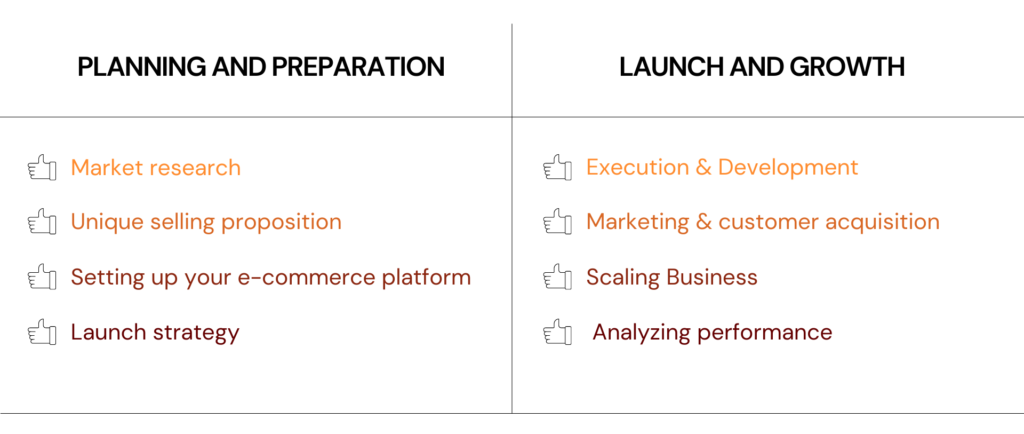Embarking on your e-commerce journey but unsure where to start? Let’s break it down into two manageable phases for beginners…
Phase 1: Planning and Preparation
- Market Research: Begin by researching your target market, including demographics, preferences, and buying behaviors. Identify potential niches and product opportunities based on market demand and competition analysis.
- Define Your Unique Selling Proposition (USP): Determine what sets your e-commerce venture apart from competitors. Clarify your brand identity, values, and the specific benefits your products or services offer to customers.
- Business Model and Legal Considerations: Choose a suitable business model (e.g., dropshipping, private labeling, or manufacturing) and register your business entity. Ensure compliance with legal requirements such as business licenses, permits, and tax obligations.
- Product Sourcing or Creation: Decide whether you’ll source products from suppliers, manufacture your own products, or offer digital products/services. Establish relationships with reliable suppliers or create prototypes for your own products.
- Set Up Your eCommerce Platform: Choose an e-commerce platform (e.g., Shopify) and set up your online store. Customize your store design, add product listings, and configure payment and shipping options.
- Develop Your Launch Strategy: Plan your e-commerce launch strategy, including promotional activities, social media campaigns, and email marketing. Generate buzz and anticipation for your launch to attract initial customers.

Phase 2: Launch and Growth
- Launch Your eCommerce Store: Officially launch your e-commerce store and make it accessible to customers. Monitor website performance, test functionality, and address any technical issues promptly.
- Marketing and Customer Acquisition: Execute your pre-planned marketing strategies to drive traffic and attract customers to your e-commerce store. Utilize a mix of digital marketing channels, including social media, content marketing, paid advertising, and influencer partnerships.
- Customer Experience and Feedback: Focus on providing an exceptional customer experience to build trust and loyalty. Gather feedback from customers through surveys, reviews, and customer support interactions. Use insights to refine your products, services, and processes.
- Analyze Performance and Iterate: Track key performance indicators (KPIs) such as website traffic, conversion rates, sales, and customer retention. Analyze data to identify trends, opportunities, and areas for improvement. Continuously iterate and optimize your e-commerce strategy based on insights and feedback.
- Scaling Your Business: As your e-commerce venture grows, explore opportunities to scale your business operations. Consider expanding your product offerings, diversifying into new markets, or optimizing processes for efficiency and scalability.
- Stay Agile and Adapt: Remain agile and adaptable to changing market conditions, consumer trends, and competitive dynamics. Stay informed about industry developments and leverage emerging technologies or strategies to stay ahead of the curve.
By breaking down the process into two manageable phases, you can approach starting your e-commerce venture with clarity, focus, and confidence. Stay committed to learning and iterating as you navigate the exciting journey of building and growing your e-commerce business.